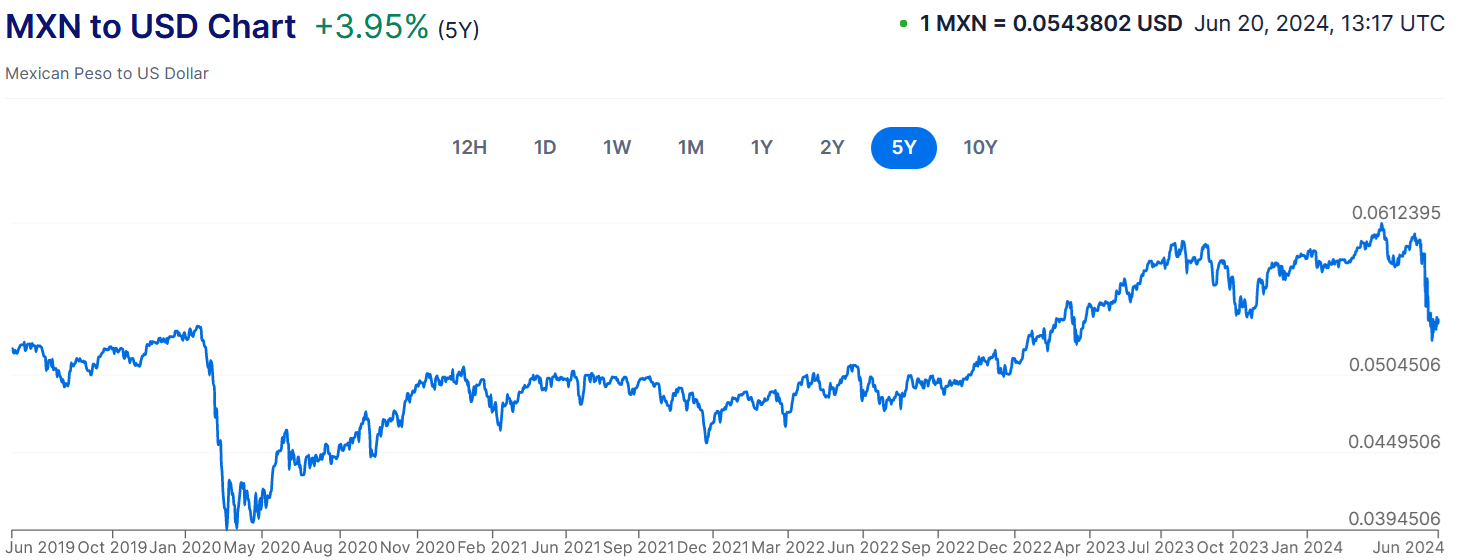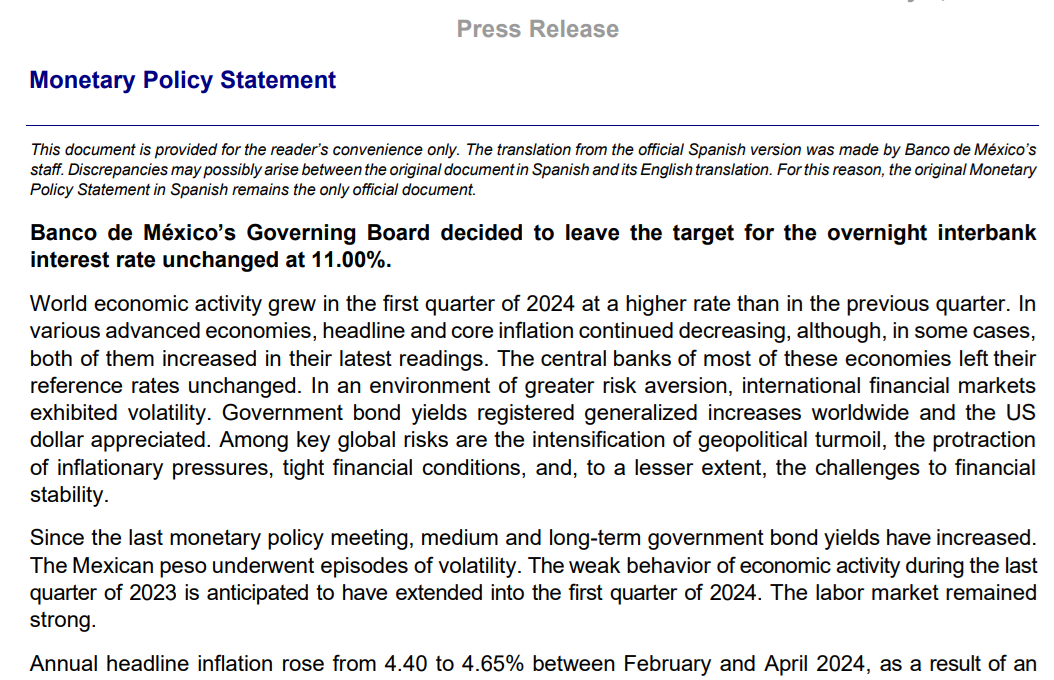Forex Trading in Mexico



Mexico is a major regional hub when it comes to currency trading. It is testament to the country’s large economy, and the substantial level of goods and services that it exchanges with the US and Canada each year.
With trading volumes mirroring those of Brazil, Mexico is the second-largest forex market in Latin America. Data from the Bank of International Settlements (BIS) shows that the average daily turnover of currency transactions in Mexico stood at $19 billion in 2022.
This guide tells you all you need to know about online forex trading in Mexico. It describes how the market is regulated, explains how forex traders are taxed, and reveals the best time of day to trade. It also illustrates how a real-life trade involving the Mexican peso (MXN) could work.
Quick Introduction
- According to the BIS, the average daily turnover of FX trades involving the Mexican peso (MXN) in 2022 totalled $114 billion. This meant it participated in around 2% of all currency deals across the globe.
- Mexico’s currency market doesn’t have specific regulations, but forex brokers should be authorized by the National Banking and Securities Commission, a body which oversees broader financial markets.
- Profits on forex trading are taxable, and subject to income tax at rates of 1.92% to 35%, in line with the Servicio de Administración Tributaria.
Top 4 Forex Brokers in Mexico
Our latest tests show these 4 platforms are the best for forex traders in Mexico:
How Does Forex Trading In Mexico Work?
Mexico has a healthy forex market, befitting the country’s position as one of the world’s largest economies and a major emerging market. The World Bank says that it is among the 15 biggest economies on the planet.
Mexico’s heavy involvement in the currency market also reflects the significant trade relationships it has with the US and Canada. This trade activity necessitates frequent forex trading involving the peso and the US dollar (MXN/USD) and the Canadian dollar (MXN/CAD).
Mexico’s trade with its two northerly neighbours has almost tripled since the North American Free Trade Agreement (NAFTA) was signed in 1994. The trade pact now goes by the name of the United States-Mexico-Canada Agreement (USMCA).
Is Forex Trading Legal In Mexico?
The National Banking and Securities Commission (Comisión Nacional Bancaria y de Valores, or CNBV) is primarily responsible for regulating Mexico’s financial markets and institutions. Its purpose is to maintain the stability, transparency and efficiency of the country’s entire financial system, and to provide protection to traders.
There is no specific framework for currency dealing specifically. But forex brokers – like other financial services companies in Mexico – should receive authorization from the CNBV to set up shop.
They must adhere to a series of key rules and regulations, and are closely supervised to ensure they are acting in a responsible and legal manner.
Is Forex Trading Taxed In Mexico?
Yes. All trading profits are subject to tax and must be notified to Mexico’s Tax Service Administration (Servicio de Administración Tributaria, or SAT).
Forex traders will pay Impuesto sobre la Renta, otherwise known as income tax, on profits, although tax is not due on the first MXN 125,900 of what you earn.
There are 11 different income tax bands in Mexico, ranging from 1.92% to 35%. More details on tax thresholds can be found here.
When Is The Best Time To Trade Forex?
Forex traders can do business 24 hours a day, five days a week, regardless of where they are based. However, trading conditions can be better at specific times, depending on where one happens to be dealing from.
In Mexico, the best period to trade currencies is arguably between 6:00 Central Standard Time (CST) and 11:00 CST. Between these times, both the London and New York markets are open, the two largest forex venues on the planet.
Trading volumes tend to be higher during these hours, providing market participants with better opportunities to book a profit. Greater turnover can lead to higher volatility, the holy grail for short-term forex traders.
Deeper liquidity also makes it easier for traders to open and close positions, and to keep costs down through narrower bid and ask spreads on the MXN/USD, for example.
A Forex Trade In Action
I’ll demonstrate how a forex trade involving the MXN might look in reality. I’ll illustrate how I could make money dealing the Latin American currency following the release of key economic data.
The Idea
My plan is to place a peso trade before the country’s central bank, the Banco de México, announces its next interest rate decision. My expectation is that rates will be kept on hold, which – based on my calculations – could lead to a strengthening in the value of the peso.
There are multiple currency crosses I can choose from to make this trade. But I decide to go for the MXN/USD, a pairing with excellent liquidity and thus potential for price volatility.

Going Long
Before the trade, I carry out fundamental research and technical analysis to ascertain how the Banco de México might act on interest rates, and the potential implications its decision could have on the MXN/USD pair.
My homework shows that money markets think there’s an 80% chance rates will remain cut, and an 80% possibility they will be unaltered. This leaves the door open for me to potentially make a tasty profit if the bank raises its benchmark, as I expect.
At around 12.55 CST, the MXN/USD is dealing at 0.0544. This means that I can get roughly 18.38 pesos for a buck.
I take out a long position by setting up a ‘take profit’ instruction at 0.0561. This order helps me manage risk by closing my position locking in earnings if the forex cross rises to this level.
I also complete a ‘stop loss’ instruction to minimize any losses if the peso unexpectedly falls. I establish this at 0.0538, at which point my position would be automatically closed.
The Outcome
Having placed my trade, I sit back and wait for the central bank to announce its decision at 13:00 CST. On this occasion, I’ve calculated correctly and the rate is indeed kept unchanged at 11%. In the minutes that follow the Mexican peso also strengthens.
However, the peso hasn’t risen as high as my ‘take profit’ level of 0.0561, so my trade is still open. Having consulted my charts again for price and volume data, I decide that the pair may struggle to reach this level, and so I manually close out my position at 0.0557, booking a profit of 13 pips.

Bottom Line
Mexico has a large and dynamic economy, making it – and its official currency, the peso – an important player in the global forex market. Traders have a wide range of forex pairings to choose from, with the MXN/USD being by far the most popular.
While Mexican financial markets are regulated, the currency market does not have its own specific framework or laws. Investors should check that the forex broker they choose is authorized to do business in Mexico.
Recommended Reading
Article Sources
- Turnover of OTC foreign exchange instruments, by country – Bank for International Settlements (BIS)
- Turnover of OTC foreign exchange instruments, by currency – Bank for International Settlements (BIS)
- Mexico – Financial Sector Assessment Program – International Monetary Fund (IMF)
- Mexico - Individual - Taxes on personal income - PwC
- Mexico – Overview- PwC
- Mexico Overview – World Bank
The writing and editorial team at DayTrading.com use credible sources to support their work. These include government agencies, white papers, research institutes, and engagement with industry professionals. Content is written free from bias and is fact-checked where appropriate. Learn more about why you can trust DayTrading.com



